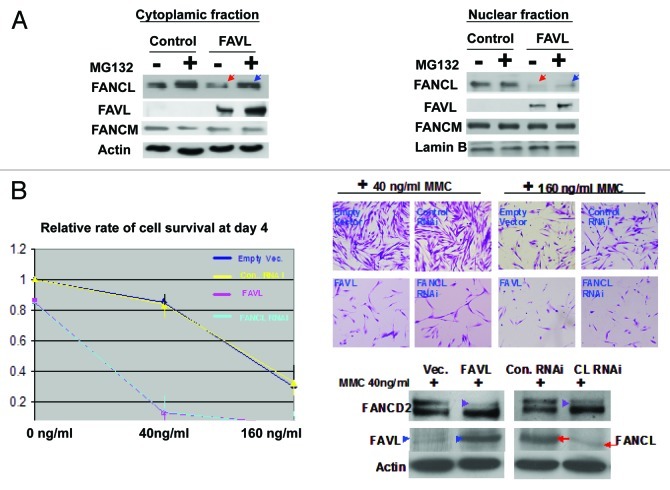Figure 4. Downregulated FANCL is a mechanism underlying the function of elevated FAVL. (A) FAVL interferes with the nuclear expression level of FANCL protein Both HTB-4 control and FAVL-overexpressed cells were first treated with or without 5 μM of MG132 for 12 h. Subsequently, cytoplasmic and nuclear fractions were prepared for western blotting analysis on FANCL, FANCM, FAVL and loading controls (actin for cytoplasmic fraction; lamin for nuclear fraction). Expression level of FANCL protein was decreased in both cytoplasmic and nuclear fractions when cells carrying a higher level of FAVL (Red arrowhead), but is relatively increased when treated with MG132 (blue arrowhead compared with the red one accordingly). The level of FANCM protein remains to be similar in cells expressing different levels of FAVL, or with or without MG132 treatment. (B) Silencing FANCL and overexpression of FAVL function in a common signaling pathway. WI-38 cells were transfected with the plasmid containing FAVL cDNA or RNAi oligos targeting FANCL as well as corresponding empty vector or non-specific RNAi oligo control, respectively. Transfected cells were treated with or without MMC in quadruplicate for three consecutive days. Subsequently, we counted these cells and took corresponding images. The rate of cell survival is similar between FAVL cDNA and FANCL RNAi transfected cells (left panel, plotted from the total number of survived cells; the corresponding images shown in right top panel). The amount of FAVL plasmid or FANCL RNAi oligos were enough to compromise FANCD2 activation (right bottom panel, marked with the purple arrowheads). The protein levels of FAVL marked with blue arrowheads) or FANCL (marked with red arrowheads) were increased or decreased, respectively, in WI-38 cells harboring FAVL cDNA or FANCL RNAi oligos.

An official website of the United States government
Here's how you know
Official websites use .gov
A
.gov website belongs to an official
government organization in the United States.
Secure .gov websites use HTTPS
A lock (
) or https:// means you've safely
connected to the .gov website. Share sensitive
information only on official, secure websites.
